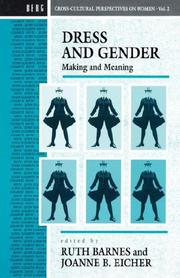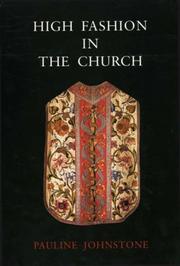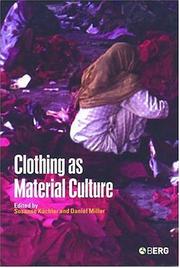Book
ISBN: 9073913756 Year: 1998 Publisher: Wielsbeke De Eenhoorn
Abstract | Keywords | Export | Availability | Bookmark
 Loading...
Loading...Choose an application
- Reference Manager
- EndNote
- RefWorks (Direct export to RefWorks)
Op de eerste linkerpagina kijkt een jongetje naar zijn onderbroekje. Boven de illustraties staat: 'Het slipje over mijn billetjes'. De vraag die aan dit antwoord en aan deze illustratie voorafgaat, staat op het voorplat: 'Wat trek ik aan?' Klein, vierkant, hardkartonnen prentenboek met twee afgeronde hoeken; in dezelfde uitvoering verschenen ook 'Wat doet de baby?' en 'Wat doet de kip?'. Bij het zien van de afbeelding op elke rechterpagina stel je steeds de titelvraag ('Wat trek ik aan?'). Na het omslaan van de bladzijde krijgt de lezer het antwoord. De lezer leert te voorspellen op welke plaats elk kledingstuk (hemd, sokken, broek, trui, schoenen, jas, muts en wanten) thuishoort. De eenvoudige en in rustige kleuren geschilderde illustraties bevatten vrijstaande figuren die een dikke blauwe contourlijn hebben. Ze staan op een sober gekleurde achtergrond van gespikkeld papier, en zijn heel herkenbaar. Doordat het omslaan van de pagina nodig is om het antwoord te zien, wordt er een bepaalde spanning opgeroepen die de aandacht vasthoudt.
Dutch literature --- aankleden (themawoord fictie) --- prentenboeken (genre) --- kleuteronderwijs (doelgroep) --- Kleding --- Aankleden --- Prentenboeken --- Kleding. --- prentenboeken --- kleding --- 2-4 jaar --- SANC --- aanwijsprentenboeken --- baby's --- kartonboeken --- kledij --- lichaam --- kleding: prentboek --- Kledij ; kleuteronderwijs --- Kleuters ; verhalen --- Prentenboeken ; verhalend
Book
ISBN: 9024821134 Publisher: Meppel Educatieve uitgeverij ten Brink
Abstract | Keywords | Export | Availability | Bookmark
 Loading...
Loading...Choose an application
- Reference Manager
- EndNote
- RefWorks (Direct export to RefWorks)
-4
kostuums --- kledij --- cultuurgeschiedenis --- #gsdbA --- kleding --- geschiedenis --- 907.1 --- kostuumkunde - algemeen --- Geschiedenis --- Kleding --- Geneeskunde --- Techniek (wetenschap) --- Atlas --- Museum
Book
ISBN: 9066303700 9789066303706 Year: 1992 Publisher: Zwolle : Utrecht : Waanders ; Rijksmuseum Het Catharijneconvent,
Abstract | Keywords | Export | Availability | Bookmark
 Loading...
Loading...Choose an application
- Reference Manager
- EndNote
- RefWorks (Direct export to RefWorks)
Christian church history --- Netherlands --- Cardinals --- Bishops --- Clothing --- 27 <492 UTRECHT> --- 264-036 --- -Cardinals --- -Archbishops --- Clergy --- Major orders --- Metropolitans --- Orders, Major --- Chaplains, Bishops' --- Episcopacy --- Kerkgeschiedenis--Nederland--UTRECHT --- Liturgische kledij: amict; albe; stool; kazuifel --- Costume --- -Kerkgeschiedenis--Nederland--UTRECHT --- 264-036 Liturgische kledij: amict; albe; stool; kazuifel --- -264-036 Liturgische kledij: amict; albe; stool; kazuifel --- Archbishops
Book
ISBN: 9068224565 Year: 1997 Publisher: Hasselt Uitgeverij Clavis
Abstract | Keywords | Export | Availability | Bookmark
 Loading...
Loading...Choose an application
- Reference Manager
- EndNote
- RefWorks (Direct export to RefWorks)
Elke morgen vergeet Let wel iets. Vandaag hangt er op de speelplaats een rode onderbroek in de boom! Is dat misschien de broek van Let? Elke morgen vergeet Let wel iets. Vandaag hangt er op de speelplaats een rode onderbroek in de boom! Is dat misschien de broek van Let? (Bron: covertekst)
Dutch literature --- scholen (themawoord fictie) --- prentenboeken (genre) --- prentenboeken --- Kleding ; verhalen --- Kleding --- Pesten ; verhalen --- Pesten --- Prentenboeken ; verhalend --- Prentenboeken --- Schoolleven ; verhalen --- Vergeten ; verhalen --- Vergeten --- Kledij

ISBN: 9780854968657 Year: 1997 Publisher: Oxford : Berg,
Abstract | Keywords | Export | Availability | Bookmark
 Loading...
Loading...Choose an application
- Reference Manager
- EndNote
- RefWorks (Direct export to RefWorks)
Book
ISBN: 3900538506 9783900538507 Year: 1997 Volume: 4 Publisher: Vienna: Fassbaender,
Abstract | Keywords | Export | Availability | Bookmark
 Loading...
Loading...Choose an application
- Reference Manager
- EndNote
- RefWorks (Direct export to RefWorks)
Silk weaving --- Textile fabrics, Byzantine --- Textile fabrics, Medieval --- 746.1 --- 264-036 --- -Textile fabrics, Byzantine --- #GBIB: fonds Van Roey / 2000 --- Medieval textile fabrics --- Byzantine textile fabrics --- Silk industry --- Weaving --- Weefkunst --- Liturgische kledij: amict; albe; stool; kazuifel --- 264-036 Liturgische kledij: amict; albe; stool; kazuifel --- 746.1 Weefkunst --- Silk weaving - Byzantine Empire

Abstract | Keywords | Export | Availability | Bookmark
 Loading...
Loading...Choose an application
- Reference Manager
- EndNote
- RefWorks (Direct export to RefWorks)
Church vestments --- Ecclesiastical embroidery --- 264-036 --- Church embroidery --- Christian art and symbolism --- Embroidery --- Church costume --- Ecclesiastical garb --- Ecclesiastical vestments --- Vestments --- Clothing and dress --- Costume --- Liturgical objects --- 264-036 Liturgische kledij: amict; albe; stool; kazuifel --- Liturgische kledij: amict; albe; stool; kazuifel --- History --- Religious aspects --- Christianity

ISBN: 1845200675 1845200667 9781845200671 9781845200664 Year: 2005 Publisher: Oxford : Berg,
Abstract | Keywords | Export | Availability | Bookmark
 Loading...
Loading...Choose an application
- Reference Manager
- EndNote
- RefWorks (Direct export to RefWorks)
In recent years, there has been a spate of books theorizing fashion. Few, however, take on board the artefactual nature of cloth. In contrast, costume historians have looked closely at garments, but have shown less concern with how clothing is informed by social structures. This book fills a major gap by combining these two "camps" through an expressly material culture approach to clothing. In sustained case studies, Kuchler and Miller argue that cloth and clothing are living, vibrant parts of culture and the body. From the recycling of cloth in Africa and India and the use of pattern in the Pacific, to the history of "wash and wear" and why women wear the wrong clothes to restaurants, this book shows the considerable advantage gained by seamlessly combining material and social aspects of dress and textiles.
Ethnology. Cultural anthropology --- Sociology of culture --- Clothing and dress. --- Material culture. --- 391.01 --- Mode ; theorie ; kleding ; materiële en sociale aspecten --- Kleding ; mode ; materieel cultureel onderzoek --- Mode ; kledij en identiteit --- Mode ; theorie, filosofie, esthetica
Book
ISBN: 9789061538202 Year: 2008 Publisher: Brussel Mercatorfonds
Abstract | Keywords | Export | Availability | Bookmark
 Loading...
Loading...Choose an application
- Reference Manager
- EndNote
- RefWorks (Direct export to RefWorks)
Belgian artist, designer, and interior decorator Isabelle de Borchgrave has created exquisite paper dresses evoking high fashions from the courts of the Medici in the Renaissance to the legendary Fortuny silks of the early 20th century. Their historical authenticity, combined with their startling realism, caused an overnight sensation when they were first shown in France in 1998 as “papiers à la mode.” Since then, the dynamic, light-hearted collection has traveled all over the world to critical and popular acclaim. Paper Illusions does full justice to De Borchgrave’s magical workshop, where paper is cut, folded, and painted on the way to being transformed into shimmering visions of beautiful clothing and luxurious living. In Rene Stoeltie’s vivid photographs, figures from the history of style seem to breathe in atmospheric rooms, while details of color, pattern, and form jump off the page. It is a publishing event of unprecedented creativity, wit, and elegance.
Borchgrave, de, Isabelle --- Clothing --- Clothing and dress --- Dress --- Habillement --- Habits --- Kledij --- Kleding --- Paper craft --- Paper folding (Handicraft) --- Paper work --- Paper-cutting --- Papercraft --- Papier [Travail du ] --- Papierbewerking --- Vêtement --- De Borchgrave, Isabelle --- Borchgrave, Isabelle de --- Manufacturing technologies --- fashion design --- papierkunst
Book
ISBN: 9789044339116 9044339117 Year: 2013 Publisher: Vianen The House of Books
Abstract | Keywords | Export | Availability | Bookmark
 Loading...
Loading...Choose an application
- Reference Manager
- EndNote
- RefWorks (Direct export to RefWorks)
Katrien Van Tongerloo, 22 januari 2015Kleine Uil houdt van een heleboel dingen, maar NIET van zijn nieuwe sjaal. Die sjaal kriebelt, is meters lang én is veel te oranje. Dat zijn begrijpelijke ergernissen, maar je kan er moeilijk bij je mama mee aankomen als net zij die sjaal speciaal voor jou heeft gemaakt ...Daarom bedenkt Kleine Uil een plan om van zijn sjaal af te raken. En daarna nog één en nog één en ... Bestaat er wel een plan dat mama niet zal dwarsbomen? Een ontzettend grappig en herkenbaar verhaal voor klein én groot! Tatyana Feeney gebruikt voor haar illustraties slechts twee andere kleuren naast grijs: oranje en petroleumblauw. Ook de illustraties zelf zijn sober. Ik vind dat deze keuze het verhaal net sterker tot zijn recht laat komen. Met weinig middelen humor brengen, is een kunst. De lay-out, het lettertype, de lettergrootte en de tekstkleur zijn weloverwogen.l Het is een grappig boek waarvan alle ingrediënten precies goed zitten.Een leuk verhaal om stilletjes bij te gniffelen.22 januari 2015© Pluizer26http://www.pluizer.be
English literature --- kleding (themawoord fictie) --- humor (themawoord fictie) --- kleuteronderwijs vierjarigen (doelgroep) --- kleuteronderwijs vijfjarigen (doelgroep) --- prentenboeken (genre) --- Sjaals --- Uilen (vogels) --- Jeugdboeken 03-06 jaar --- Prentenboeken --- PXL-Education 2019 --- kinderboek --- voorleesboek --- kleuters --- kledij --- Kleding --- Slim zijn --- Sjaal --- Uil (vogel)

 Search
Search Feedback
Feedback About UniCat
About UniCat  Help
Help News
News